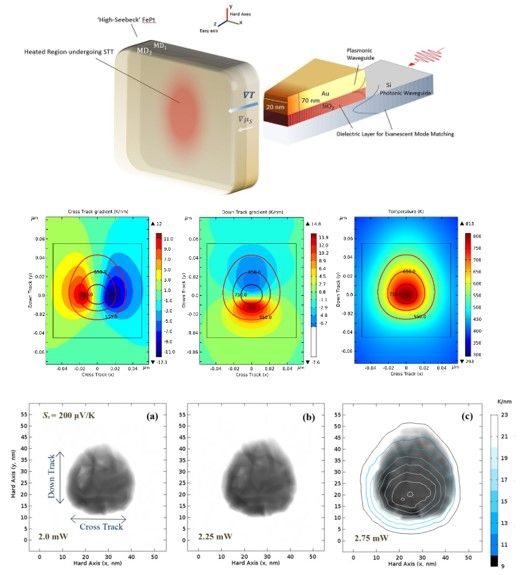Heat Assisted Magnetic Recording (HAMR)
We research optics and spintronics with an emphasis on light-matter interactions in nanostructures which produce high heat energy along with slow and trapped light phenomena. This includes behavior in low dimensional photonic and plasmonic devices with applications towards quantum information processing, solar harvesting, and environmental sensing. Many of these projects involve strong collaborations with experimental groups and industry partners which undertake numerical and analytical modelling.
Thin-Films. In particular, we have explored the fundamental properties of epsilon-near-zero (ENZ), i.e. low permittivity, thin films. This includes their antireflective, absorptive, and diffractive properties due specifically to their hyperbolic character and ability to produce slow light. The desired behavior of radiative and non-radiative ENZ modes are prominent within ultrathin (< 10 nm) films. The research undertaken is envisioned to spearhead designs for low or zero-loss meta films. Our work has predicted gain-induced enhancement of absorption within radiative ENZ modes, which leaves us confident that a suitable layered metamaterial can be developed to significantly reduce loss in photovoltaic devices, with immediate application to multi-junction or Si-based solar cells.
Quantum Emitters. Within 2D/thin-film layers light can be strongly coupled to embedded QEs, making thin films advantageous not only for energy storage but for data processing by controlling the spectral emission and entanglement of the emitters. They are then able to produce coupled photons or polaritons for performing quantum algorithms with a high fidelity. Within this past year, our work has demonstrated the ability of a near-field transducer (NFT) to strongly couple light with a quantum dot. This work is envisaged as a benchmark for the realization of a fully integrated device in which quantum mechanical data may be initialized and then manipulated with the precision of sub-diffraction focused light or heat.
Over the past decade, the ordering of nanoparticle arrays, e.g. spacing of QEs and their size, has greatly improved in order to create coupled particles and transfer information. In addition, NFTs are now able to diffract light on length scales comparable to magnetic domains or nanoscale lattice constants of particle arrays. The photonics group at Trinity College Dublin has focused much attention on producing NFTs for use in heat-assisted magnetic recording, or HAMR, devices and suitable magnetic media for data storage. This work has led to 4 US patents for NFTs with our partners at WDC. A recent article resolves a method for nanoscale bit writing and data storage. This method demonstrates the ability to produce enough heat current using a nanoscale plasmonic NFT in order to manipulate the spin polarization of magnetic domains via spin transfer torque (STT). We achieve this by taking advantage of the spin-dependent Seebeck effect within ultrathin magnetic media, which is proportional to the thermal gradient induced. Media demonstrating a large enough Seebeck effect enables heat (even residual) to either be converted to an electric or spin current. Crucially, unlike state-of-the-art HAMR devices, this method does not require to heat the media above its Curie temperature. This will open up a wider range of materials that can be used for manipulating quasiparticles using an NFT.

Figure shows geometry of the NFT and media on top, middle shown thermal gradients and bottom shown “writing” of bits
Reference
Shaping and Storing Magnetic Data Using Pulsed Plasmonic Nanoheating and Spin-Transfer Torque Frank Bello, Stefano Sanvito, Ortwin Hess, and John F. Donegan, ACS Photonics 2019 6 (6), 1524-1532 DOI: 10.1021/acsphotonics.9b00295
